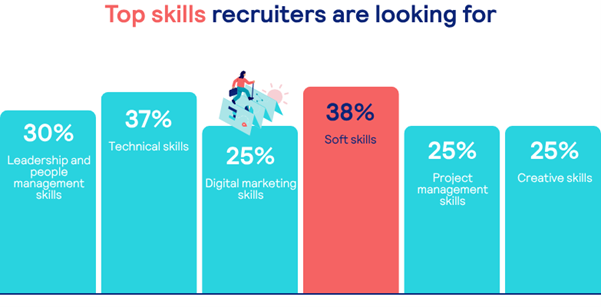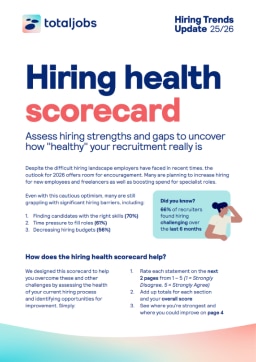
Employers looking to prioritise skills-based hiring and soft skills in 2026
Table of Contents
- Top skills-based hiring takeaways
- The shift towards skills-based hiring
- The candidate perspective on skills
- Getting started
- Your hiring solutions partner
- About the research
- FAQs

Skills Based Hiring Template
The latest edition of the Totaljobs Hiring Trends Update explores the trends around skills in the current hiring landscape. Specifically, the findings examine the challenges, opportunities, and growing importance of identifying and developing the skills that matter most for the future workforce.

Get your step-by-step guide for implementing skills-based hiring
Based on a survey of 900 HR leaders and 2,000 candidates across the UK, we’ve uncovered crucial insights to help employers and recruiters futureproof their 2026 hiring strategies and stay competitive in a fast-evolving labour market.
Top skills-based hiring takeaways
- 70% of recruiters say finding candidates with the right skills is a challenge
- Skills-based hiring is the top priority for businesses (43%) in 2026
- Soft skills such as problem-solving, collaboration, and communication are on top of recruiters’ list when it comes to skills (38%)
- 94% of businesses use skills assessments to ensure candidates possess the required skills

Join our webinar on 26th November for practical skills-based hiring tips and advice
What every employer needs to known about skills-based hiring
The shift towards skills-based hiring
Our research shows that demand for talent is clustering around specific sectors and capabilities, with recruiters prioritising:
- Soft skills (38%)
- Technical skills (37%)
- Leadership and people management skills (30%)
- Digital marketing skills (15%)

A diverse workforce, with varied lived experiences that reflect the customer base, is crucial for modern businesses. If the people designing products, testing services, or engaging with customers can’t relate to their perspectives, there’s a real risk that offerings will miss the mark entirely. Diversity of thought leads to solutions that truly resonate.
Bianca Stringuini, Global Inclusion Lead, The Stepstone Group
As a result, many organisations are rethinking their approach to recruitment, with 43% now making skills-based hiring a strategic priority. This approach shifts the focus away from traditional markers such as:
- Previous job titles
- Formal qualifications
- Years of experience
Instead, skills-based hiring evaluates candidates on the actual competencies and capabilities they bring to the table. This shift is reflected in over half (53%) of businesses requiring formal proof of skills, whereas 33% require it depending on the role. Moreover, 94% of businesses have implemented structured skills assessments as part of their recruitment process.

The benefits of a skills-based approach
There are significant advantages that come with this shift towards skills-based hiring. From an employer’s perspective, the two clear benefits are:
- Addressing skills shortages: By targeting specific skills gaps within their organisations, employers can sharpen their hiring focus. For instance, companies in tech, healthcare, and logistics can look to map required skills to business outcomes, enabling more agile workforce planning as a result.
- Promoting inclusive hiring: Skills-based recruitment prioritises ability over background, helping to reduce unconscious bias and promote diversity. When employers assess candidates on what they can do rather than where they studied or previously worked, they open the door to underrepresented talent pools and strengthen workforce inclusivity.

Replacing people like for like rarely fuels growth. New hires who approach challenges in the same way as their predecessors won’t disrupt old thinking or challenge the status quo. Hiring for skills and potential instead unlocks innovation, allowing employers to bring in fresh perspectives, even those from outside their industry, that can translate into a genuine competitive advantage.
Bianca Stringuini, Global Inclusion Lead, The Stepstone Group
The candidate perspective on skills
Our research uncovered that 14% of workers are unsatisfied with how they are applying their skills in their current role, a figure that rises to as high as 22% among 50- to 59-year-olds in the workplace.
The top reasons workers gave for not being satisfied with how their skills are applied in the workplace include:
- No opportunities for professional development or training (36%)
- Work is too monotonous and does not offer any challenges (31%)
- The work environment is not conductive to creative work (26%)
- Feeling they are being misused and could do more in another area (26%)
These findings show that employees are eager to learn, grow, and apply their skills more effectively. Providing clear pathways for professional development, upskilling, and internal mobility can significantly boost engagement and retention.
Moreover, this highlights the importance of effective skills-based hiring. When candidates are placed in roles that fully utilise their abilities, they are more likely to be productive, motivated, and loyal, reducing turnover and improving performance.
Getting started with skills-based hiring
With the importance of this hiring model clear, employers need to act swiftly to integrate skills-based practices into their recruitment processes.

Let’s take a look at some of the key steps to getting started.
Redesigning job descriptions
Job adverts and descriptions are central to any hiring process, and even more so in a skills-based model.
Traditional listings tend to emphasise qualifications or years of experience. A skills-based description, however, focuses instead on the competencies and outcomes required for success in a given role.

Top tip: Review all open roles to ensure job descriptions highlight the core skills, behavioural attributes, and measurable outcomes expected. Include examples of what success looks like in the role.
Implement structured assessments
When hiring for skills, organisations need a clear framework to measure and validate candidates’ abilities. Without it, it’s difficult to gauge whether applicants truly possess the competencies required.
86%
of recruiters require a formal proof of skills
Effective assessment methods include:
- Practical or situational tests that mirror real-world job tasks
- Work samples or portfolios showcasing previous achievements
- Competency-based interview questions tailored to key skills
- Digital skills platforms or gamified testing tools that evaluate proficiency objectively

Top tip: Combine multiple assessment methods to get a more rounded view of each candidate’s abilities. For example, pair a practical task with a structured interview to measure both technical expertise and problem-solving. This blended strategy improves accuracy and reduces bias in hiring decisions.
Ensuring hiring team alignment
A successful transition to skills-based hiring requires alignment and confidence across hiring teams. Without this, processes are likely to be fragmented, creating barriers to adoption.
As a result, it’s vital that recruiters, managers, and talent acquisition professionals are given the training they need to carry out skills-based hiring practices. This includes, for example, being able to evaluate talent objectively and interpret assessment data consistently.

Top tip: Provide training workshops or skills calibration sessions to help hiring teams understand how to assess and score candidates effectively. Encourage collaboration between HR, line managers, and department heads to maintain consistency across roles.
Totaljobs – Your hiring solution partner
Work with an industry-leading hiring solutions provider that understands your challenges and can help you find the skilled talent you need.
Part of the global recruitment technology company, The Stepstone Group, Totaljobs is a cutting-edge recruitment solutions partner whose goal is to find the right job for everyone. Find the right people for your business by reaching wider talent pools, increasing your brand’s visibility, and maximising your hiring budget.
About the research
The Hiring Trends Update is a bi-annual piece of research that checks the current pulse of the recruitment market. We surveyed 900 HR professionals and 2,000 UK candidates between 3rd-5th of September. All responses were collected online and the candidate survey is representative of the UK population by gender and age.
Frequently asked questions (FAQs)
Why is skills-based hiring becoming a top priority for employers?
Skills-based hiring helps businesses address talent shortages, improve workforce agility, and promote fairer, more inclusive recruitment by focusing on ability rather than background.
Which skills are most in demand?
The top skills include soft skills (38%), technical skills (37%), leadership and people management (30%), and digital marketing (15%). These align with employers’ needs for adaptable and multi-skilled talent.
How are employers assessing skills in the hiring process?
Around 94% of businesses use structured skills assessments, including practical tests, competency-based interviews, and digital testing tools to verify candidates’ abilities accurately.
How does a skills-based approach benefit diversity and inclusion?
By removing barriers like degree requirements or job titles, skills-based hiring opens opportunities for diverse and underrepresented talent, reducing unconscious bias in recruitment.
How can businesses start implementing skills-based hiring?
Employers should begin by redesigning job descriptions to highlight skills and outcomes, integrating structured assessments, and ensuring alignment across hiring teams through training and calibration sessions.
How does skills-based hiring help address skills shortages?
By mapping specific skills to business needs, employers can target gaps directly and recruit talent that supports key growth areas, particularly in sectors like tech, healthcare, and logistics.
Receive the latest recruitment resources and
advice to boost your hiring
By providing us with your details you agree to our privacy policy and for us to keep you updated with the latest news, events,
and special offers from Totaljobs.







